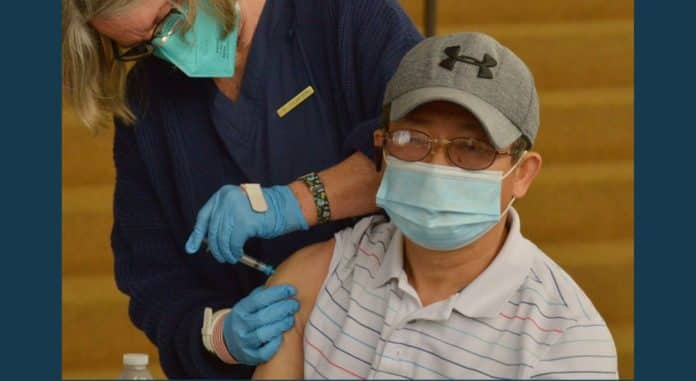May 17 (UPI) — Coronavirus deaths and cases are stabilizing throughout the world with the exception of India where nearly 27,000 people have died and 2.7 million more become became infected.
Since the pandemic outbreak began in late 2019 in Mainland China, the pandemic has killed 3,390,666 with 163,610,756 cases so far Sunday, according to tracking by Worldometers.info. Through Saturday, deaths have declined 12% in one week and cases 4%.
India has risen to third in the world with 270,284 fatalities, including 4,077 Sunday, which is lower than the record 4,200 last week. Only two other nations have reported more than that in one day, the United States 4,474 and Brazil with 4,211. The United States previously had the infections record with 299,786.
Among nations in the top 10 for most deaths, increases have only been posted in India with 4%, Colombia with 9% and Russia with 1%. Like India, the outbreak has been surging in Colombia, which entered the top 10 for the first time, displacing Spain, with 80,780, including 530 Saturday, only behind India and Brazil.
The United States, which has the most deaths with 585,944, dropped 9% through Saturday. Brazil is second with 434,852, declining 10%.
The cases surge in India is diminishing with a 13% decline in the past week. On Sunday, the Asian nation reported 311,170 infections compared with a record 414,188 on May 7. Its total is 24,684,077, which is second behind the U.S. with 32,924,567 cases. The U.S. dropped 24% in one week.
Brazil is third with 15,590,613 cases, gaining 4% through Saturday.
India accounted for 51.4% of the 634,077 cases Saturday, which were 326,098. The 3,890 deaths were 32% of the 12,153 fatalities.
Despite high daily data, India’s per capita figures are lower than the world — 194 deaths per million and 17,735 cases. The world average is 434.4 deaths and 20,945 cases with the United States at 1,803 fatalities and 101,284 infections. Brazil has 2,033 deaths per million and 72,897 cases per million.
The world’s second-largest nation of 1.4 billion has been lagging in vaccines though it is a dominant manufacturer of the doses worldwide. Only 10.3% of the residents have received at least one dose. Worldwide, 1.4 billion shots have been given in the population of 7.9 billion with a two-dose regimen required for most brands.
The United States has administered at least one dose to 47.6% of its population with Brazil at 18.2%, according to tracking by Bloomberg. Britain, which inoculated the first person in the world in December, is among the best in the world with 54.4%.
The top vaccine makers are U.S.-based Pfizer and Germany’s BioNTech, Moderna and Johnson & Johnson.
Since May 1 in India, anyone aged 18 or over is eligible for a vaccine though there are shortages.
The government was setting up new hospitals and oxygen generating plants as well as increasing supplies of medicines and vaccines. About 90 percent of intensive-care-unit beds in the Delhi region remain occupied.
On Saturday, Prime Minister Narendra Modi hosted a meeting on COVID-19 response, calling for increased testing in high positivity areas, preparing localized containment strategies and ramping up vaccinations.
On Friday, Modi told the nation about the “invisible enemy.”
“I want to warn you about corona,” he said. “This pandemic is spreading fast in rural villages. Every government is making efforts to stop this. But awareness of this among rural people and the cooperation of panchayats is equally important.”
A lockdown in India’s capital region of Delhi which began on April 19 was set to end Monday but a one-week extension was announced Sunday.
Though COVID-19 originated in Mainland China, the nation with the world’s largest population of 1.5 billion has reported only a few deaths in the past 12 months and stands in 60th at 4,636 behind Azerbaijan with 4,779. China added 18 cases Sunday.
Iran has the second-most deaths in Asia and 12th worldwide with 303 reported Sunday.
Turkey ranks fifth in the world for cases at 5,106,862 with 11,472 Saturday and 19th in deaths at 42,746, including 236 most recently.
In the Far East, Indonesia has the most deaths, 48,093 in 17th place with 123 reported Sunday.
Japan is 39th with 11,537 deaths, including 47 on Sunday with the record 148. Cases are 5,2617 with the record 7,882.
Six areas are currently under a full-fledged emergency, including Tokyo, where the Summer Olympics are scheduled to start on July 23. Another 13 are in a quasi-state of emergency through June 13, including Okinawa.
Nearly 70% of the Japanese population do not want the Olympics to take place, but the International Olympic Committee and the government want them to proceed. A contract between the IOC and host city only allows the IOC to cancel the games. The Olympics already were postponed from 2020.
Japanese athletes have been participating in tests events at different venues called READY STEADY TOKYO, including 3-3 basketball Friday through Sunday Aomi Urban Sports Park.
Japan has vaccinated only 3.2% of the population with at least one dose.
South Korea has vaccinated 7.2%. The nation has 1,900 deaths, including four more Sunday, and 131,671cases, with a rise of 610. The record is 40 deaths and 1,241 cases.
South Korea’s tighter restrictions last through May 23 in Seoul and its surrounding Gyeonggi province.
Conversely, Israel, which is considered part of Asia, has fully vaccinated 60% of its population, among the best in the world. Its death toll is 6,381, rising by five in one week, including none Sunday.
Among the continents, Asia has surged to first place in cases with 46,832,312 but its fourth in deaths with 608,179. Its deaths dropped 14% and cases rose 2%.
In South America, deaths have increased 5% in one week and cases are down 4%. In all, the continent’s death toll is 726,776 and 26,707,858 cases, with four nations in the top 10 in fatalities.
Besides Brazil and Colombia, Argentina is 14th with 67,042 deaths, including 400 Saturday, and Peru in 15th with 65,911, with 303 most recently.
In the past week, the continent’s deaths rose by 24,494, which is 28.3% of the world total though the population is only 5.5%. Cases dropped 3%.
Chile, which ranks 23rd in the world with 27,832, including 98 Saturday, leads South America in vaccination percentage with 47.2% of its 19.3 million population receiving at least one shot.
Besides Brazil, the percentages are 8.9% in Colombia, 5.2% in Peru and 17.8% in Argentina.
Coronavirus is high in Brazil though deaths and cases are trending down. Brazil posted a record 4,211 on April 6 with Saturday’s increase of 2,067. Cases were 69,300 Saturday compared with a record 97,586 in March and a one-week gain of 2%.
An official inquiry was opened late last month to investigate the government’s handling of the pandemic. President Jair Bolsonaro, who opposes lockdowns, masks and vaccinations, said he is “not worried” about the investigation.
With Colombia moving up to 10th with the most deaths, five European nations are in the top 10 for most deaths: Britain fifth with 127,679, Italy sixth with 124,156, Russia seventh with 115,871, France eighth with 107,616, Germany ninth with 86,722. Besides Spain in 11th with 79,739, two other European nations have have been stabilized after a surge a few weeks ago. Poland is 13th at 71,664, including 55 Sunday and a record 954 on April 8. Ukraine is 18th at 48,075, including 133 Sunday after record 481.
Overall, Europe’s deaths are down 13% and cases 20% in one week. The totals are 1,049,521 fatalities and 46,066,273 infections. Asia displaced South America for most cases but is No. 1 for deaths.
Britain added only 72 deaths in the past week. A more contagious strain was first found there and it hit 1,823 fatalities in one day in January. France was at 1,571 in the past week,, Italy at 1,369, Germany at 1,416 and Spain at 513. The biggest death gainers in Europe were Russia with 2,488, Poland with 1,744, Ukraine with 1,742.
Behind Britain in vaccinations are 36.6% in Germany, 32.1% in Spain, 31% in France, 30.9% in Italy, 29.8% in Poland, 8.2% in Russia, 2.3% in Ukraine.
On Sunday, Britain reported four deaths and 1,926 cases. Italy gained 93 deaths and 5,753 cases Sunday, Russia 391 deaths and 8,554 cases Sunday, France 81 deaths and 13,948 cases, Germany 53 deaths and 6,073 cases.
Prime Minister Boris Johnson has pushed to accelerate second doses of vaccines amid a contagious variant from India.
“The race between our vaccination program and the virus may be about to become a great deal tighter, and it’s more important than ever therefore that people get the protection of a second dose,” said Johnson.
Plans are to inoculate everyone by July.
He warned further steps to get out of the lockdown might be delayed because of the variant concerns.
On Monday, people can meet in groups of up to 30 outdoors. Also allowed will be indoor dining and drinking with indoor entertainment, including concert halls and theater, allowed. And face coverings will no longer be recommended for students in secondary schools and in-person teaching for all remaining college students.
Britain has a travel ban to many nations though it has enacted its first “green list,” allowing people to travel to other countries, including Israel and Portugal, starting May 17 and return home without the need to quarantine.
In France, all travel to and from non-European countries is banned, although it is hoped the country will be ready to open to them in June with “green cards.”
Italy, which is in a semi-lockdown, depending on the region, is also planning “green cards” to avoid the need for quarantine.
Germany, which is in a lockdown, allows travel to EU members, Schengen states and nations with low infection rates. But they must prove a negative tests before traveling. Those from high-risk area must quarantine for 10 days.
In Spain, the six-month lockdown ended May 9. Regarding travel, it’s banned from those outside EU/Schengen until May 31. Those arriving from the EU and Britain must have a negative covid test within 72 hours.
In North America, the nonessential travel ban among Mexico, Canada and the United States has been extended through May 21. It began one year ago in March.
Cancun is a popular tourist destination. Though the airport recorded more than 692,000 passenger arrivals in March, the area is in the midst of restrictions because of an increase of cases 65% there. On May 3, Gov. Carlos Joaquín moved Quintana Roo to high-risk orange, meaning bars and nightclubs are closed; restaurants, hotels and theme parks are limited to 50% capacity with beaches, parks, movie theaters and salons limited to 30%.
North America is second behind Europe for deaths with 878,629, and cases with 39,194,793. In one week, fatalities are down 18% and cases 7%.
Vaccination rates are much different in the two U.S. neighbors: Mexico at 11.8%, though it was the first Latin American nation to begin vaccinating people, and Canada at 39.4%, which is 7.7% less than the United States.
Deaths have been easing in Mexico with 221 Saturday, down from a single-day record 1,803. Cases were 2,695 for a total of 2,380,690, which ranks 15th.
Canada, which has 29% of Mexico’s population, has reported under triple digits for deaths since 142 on Feb. 3 and a record 257 on Dec. 29, including 37 Sunday for a total of 24,945. Cases were 3,760, behind the record 11,383.
By the summer, the Public Health Agency of Canada hopes to allow camping, hiking and picnics but avoidance of crowds of 76% of those eligible for vaccines have at at least one dose and 20% both.
In the fall, indoor gatherings with people from different households, indoor sports and family gatherings will be allowed if the vaccination rate hits 75%. Conversely, in the United States masks and social distancing are not recquired for fully vaccinated individuals.
“For now, you need to keep following public health advice, whether or not you’ve been vaccinated, to keep yourself, your family, and your community safe. More people need to be vaccinated before we can ease restrictions,” said Canadian Health Minister Patty Hajdu.
Oceania, with only 42.3 million people, has 1,225 deaths and 65,916 cases.
New Zealand’s deaths remain at 26 with the last one reported on Feb. 16 and Australia’s toll stayed at 910 with one reported April 13.
New Zealand reported one case Sunday, tallying 28 in one week, for a total of 2,646, and Australia was up 8, which is 63 in a week, for 29,975 total.
Australia has vaccines available for 6.0% of the population with dosage administration not available. New Zealand has administered first doses to 5.5% of its population.
Australia’s international borders will remain closed largely until mid-2022, according to federal budget papers. That though the nation expects to have everyone fully vaccinated by the end of this year. All Australians older than 50 can get a vaccine.
Prime Minister Scott Morrison posted on Facebook last week the 2021 budget “is all about securing our economic recovery from COVID-19, creating more jobs and better jobs, keeping our economy strong so we can guarantee the essential services Australians rely on, and building a stronger and more resilient Australia so we can keep Australians safe in these uncertain times.”
Africa has reported 126,476 deaths and 4,724,819 cases. In one week, it’s a 4% decline of deaths and 12% cases.
South Africa has 55,183 deaths, including 59 on Saturday and 2,750 cases despite a more contagious strain originating there. Egypt is second with 14,269 and Tunisia third with 11,779.
The nation has been bracing for a third wave with it already occurring in the economic hub of Gauteng province where they climbed from 600 to 1,200 in one day last week.
South Africa, which is dealing with a variant, has vaccinated 0.7% of its population with its first dose. Among continents, Africa has the slowest rate of vaccinations at 1.7%, according to tracking by The New York Times. North America leads with 53%, followed by Europe at 38%, South America at 22%, Asia at 15% and Oceania at 8.5%.







